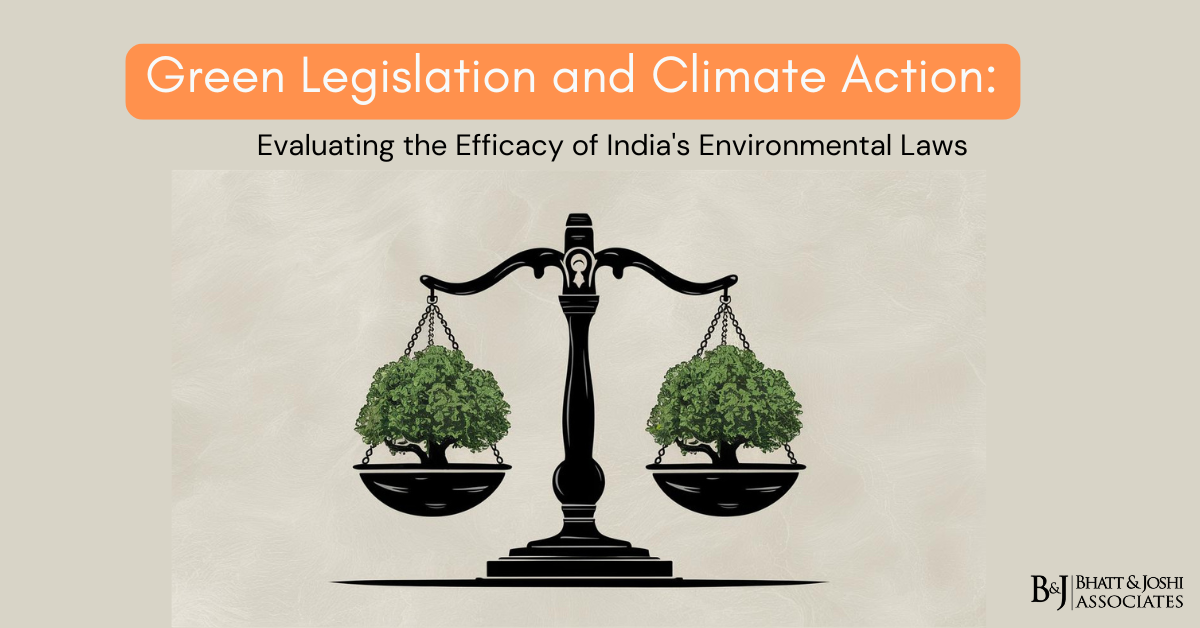Introduction
India, with its vast and diverse landscapes, faces significant environmental challenges, including severe air and water pollution, deforestation, loss of biodiversity, and the impacts of climate change. The country has established a comprehensive legal framework aimed at protecting the environment and promoting sustainable development. However, the effectiveness of these laws is often questioned, particularly in the context of enforcement, public participation, and policy coherence. This article provides an in-depth evaluation of the efficacy of India’s environmental laws, with a particular focus on climate action, highlighting the strengths, weaknesses, and areas for improvement. India’s environmental challenges are diverse and complex, shaped by its rapid economic growth, high population density, and varied geography. Air pollution is one of the most pressing issues, with major cities like Delhi experiencing hazardous air quality levels, primarily due to vehicular emissions, industrial discharges, and agricultural practices such as stubble burning. Water pollution is equally concerning, with the contamination of rivers, lakes, and groundwater sources posing serious health risks and contributing to water scarcity. The degradation of forests and loss of biodiversity further exacerbate environmental degradation, while climate change poses a long-term threat with wide-ranging impacts on agriculture, water resources, and human health.
The Legal Framework for Environmental Protection in India
India’s environmental legal framework is grounded in constitutional provisions, various statutes, and regulatory bodies designed to manage and protect the country’s natural resources. The Constitution of India, under Article 48A, mandates the state to protect and improve the environment, while Article 51A(g) imposes a duty on every citizen to protect the natural environment, including forests, lakes, rivers, and wildlife. These constitutional mandates provide the foundational principles guiding India’s environmental policies and legislation. The Environment (Protection) Act of 1986 serves as the umbrella legislation for environmental protection in India, empowering the central government to take necessary measures to protect and improve environmental quality. This Act enables the government to set standards for emissions and discharges of pollutants, regulate industrial activities, and implement policies for environmental conservation. Additionally, the Air (Prevention and Control of Pollution) Act of 1981 and the Water (Prevention and Control of Pollution) Act of 1974 specifically address air and water pollution, respectively, by establishing regulatory frameworks and setting up the Central and State Pollution Control Boards (CPCB and SPCBs). The Forest (Conservation) Act of 1980 and the Wildlife (Protection) Act of 1972 focus on conserving forests and wildlife, regulating activities that could lead to deforestation and the exploitation of wildlife resources. The National Green Tribunal Act of 2010 established the National Green Tribunal (NGT), a specialized judicial body tasked with adjudicating environmental disputes and ensuring the enforcement of environmental laws. The NGT provides a platform for individuals and organizations to challenge actions that harm the environment, thus playing a crucial role in environmental governance.
Climate Action and India’s Commitments
India’s approach to climate action is shaped by its commitments under international agreements, particularly the United Nations Framework Convention on Climate Change (UNFCCC) and the Paris Agreement. Under the Paris Agreement, India has pledged to reduce the emissions intensity of its GDP by 33-35% by 2030 from 2005 levels, achieve 40% of its electricity capacity from non-fossil fuel sources, and increase forest and tree cover to act as a carbon sink. These commitments are part of India’s Nationally Determined Contributions (NDCs), which outline the country’s specific targets and strategies for mitigating and adapting to climate change. The National Action Plan on Climate Change (NAPCC), launched in 2008, is a key component of India’s domestic climate policy. It comprises eight national missions, focusing on areas such as solar energy, energy efficiency, sustainable agriculture, water conservation, and the protection of the Himalayan ecosystem. The NAPCC aims to integrate climate action into national development strategies, promoting sustainable growth while addressing climate vulnerabilities.
Evaluation of the Efficacy of India’s Environmental Laws
The efficacy of India’s environmental laws is a subject of ongoing debate, influenced by factors such as enforcement challenges, public awareness, and policy coherence. Despite having a comprehensive legal framework, the implementation and enforcement of environmental regulations often fall short of their intended goals. One of the critical challenges is enforcement. Regulatory bodies like the CPCB and SPCBs often face resource constraints, including inadequate staffing, funding, and technical expertise, which hinder their ability to monitor compliance and enforce standards effectively. This issue is compounded by the high caseloads and limited capacity of the judicial system, including the NGT, which can delay the resolution of environmental disputes and the implementation of corrective measures. Moreover, industries and businesses may not fully comply with environmental standards due to weak enforcement mechanisms and the absence of stringent penalties for violations. Public awareness and participation are crucial for effective environmental governance, yet these are areas where India faces significant challenges. While legal provisions like the Right to Information Act (RTI) provide mechanisms for accessing environmental information, public awareness about environmental issues and legal rights remains limited. This gap hampers the ability of communities to engage in environmental decision-making processes and hold authorities accountable. Furthermore, mechanisms for community involvement in environmental governance, such as public consultations and hearings, are often inadequate or not effectively implemented, limiting the influence of local voices in shaping environmental policies. Policy coherence and integration are also critical for addressing environmental challenges. India’s environmental policies sometimes lack alignment with other sectoral policies, leading to conflicting objectives. For example, policies promoting the use of water-intensive crops or providing subsidies for fossil fuels can undermine efforts to conserve water resources and reduce greenhouse gas emissions. Additionally, the fragmentation of responsibilities across multiple agencies and ministries can lead to overlapping mandates and coordination challenges, further complicating the implementation of cohesive environmental strategies.
Climate Adaptation and Resilience
Climate adaptation and resilience are key components of India’s environmental strategy, given the country’s vulnerability to climate impacts such as extreme weather events, changing precipitation patterns, and rising temperatures. Building climate resilience involves enhancing the capacity of communities, infrastructure, and ecosystems to withstand and recover from climate-related shocks. Developing climate-resilient infrastructure, such as flood defenses, drought-resistant agricultural systems, and sustainable urban planning, is crucial for minimizing the adverse effects of climate change. However, this requires significant investment and technical capacity, which are often constrained. Moreover, marginalized and vulnerable populations, including low-income communities, rural residents, and indigenous peoples, are disproportionately affected by climate impacts. Ensuring equitable access to resources, support for adaptation, and participation in decision-making processes is essential for building inclusive and effective resilience strategies.
Case Studies and Examples
Several case studies illustrate the successes and challenges in India’s environmental governance. The issue of air pollution in Delhi is a prominent example, where despite numerous measures, air quality remains a major public health concern. Efforts such as the Graded Response Action Plan (GRAP) and the introduction of Bharat Stage VI (BS-VI) emission standards have been implemented to mitigate pollution levels. However, these measures face challenges related to enforcement, public compliance, and regional cooperation, particularly in addressing the issue of stubble burning in neighboring states. The conservation of the Western Ghats, a biodiversity hotspot, highlights the complexities of balancing development and conservation. Reports like those from the Western Ghats Ecology Expert Panel (WGEEP) and the Kasturirangan Committee have proposed different approaches to protecting the region while considering the needs of local communities. The debate over the extent and strictness of protection measures continues, reflecting broader challenges in environmental policy-making and governance. The rejuvenation of the Ganga River under the Namami Gange program represents another significant effort in India’s environmental landscape. The program aims to address pollution from sewage, industrial discharges, and agricultural runoff, which have severely degraded the river’s water quality. While progress has been made in constructing sewage treatment plants and regulating industrial effluents, the program faces challenges related to project implementation, maintenance, and ensuring sustainable community practices.
Recommendations for Strengthening India’s Environmental Laws and Governance
To improve the effectiveness of India’s environmental laws and address ongoing and emerging challenges, several recommendations can be made:
- Strengthening enforcement mechanisms is crucial for ensuring compliance with environmental regulations. This includes increasing resources for regulatory bodies, such as the CPCB, SPCBs, and the NGT, to enhance their capacity for monitoring, inspection, and enforcement. Improving accountability through stringent penalties for violations and enhancing transparency in enforcement actions can also deter non-compliance.
- Enhancing public awareness and participation is vital for building a culture of environmental stewardship. Environmental education should be integrated into school curricula and public outreach programs to raise awareness about environmental issues and legal rights. Additionally, strengthening mechanisms for community participation in environmental decision-making, such as public hearings and consultations, can ensure that local voices are heard and considered in policy-making processes.
- Promoting policy coherence and integration is essential for achieving sustainable development goals. Effective inter-agency coordination can prevent policy fragmentation and ensure that environmental considerations are integrated into sectoral policies, such as those related to agriculture, industry, and urban development. Implementing green budgeting practices, where environmental considerations are factored into budgetary processes and decision-making, can also support sustainable development.
- Supporting climate adaptation and resilience requires targeted investments in infrastructure and planning to withstand climate impacts. This includes developing climate-resilient infrastructure, such as flood defenses and drought-resistant agricultural systems, and providing support for vulnerable communities. Equitable access to resources and support for adaptation is crucial for ensuring that all segments of society can build resilience to climate change.
- Leveraging technology and innovation can enhance environmental monitoring, enforcement, and sustainable practices. Utilizing remote sensing technologies and data analytics can improve environmental monitoring and provide real-time information for decision-making. Promoting the development and adoption of green technologies, such as clean energy, waste management solutions, and sustainable agriculture practices, can reduce environmental impacts and support sustainable development.
Conclusion
India’s environmental laws and policies provide a robust framework for addressing the country’s diverse environmental challenges and advancing climate action. However, the effectiveness of these laws depends on the strength of enforcement mechanisms, the level of public engagement, the coherence of policies, and the capacity to adapt to emerging challenges. As India continues to develop and urbanize, the need for sustainable practices and strong environmental governance becomes increasingly critical. By strengthening enforcement, enhancing public awareness, ensuring policy integration, supporting climate resilience, and leveraging technology, India can enhance its environmental governance and contribute to global efforts to combat climate change and protect natural resources. The path forward requires collective action, innovative solutions, and a steadfast commitment to sustainability and environmental justice.














